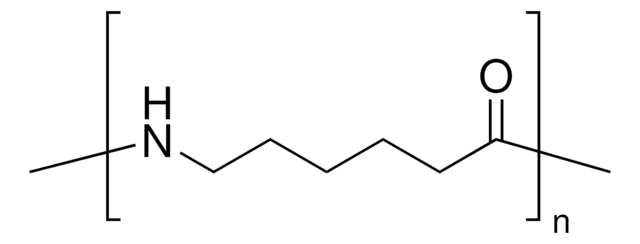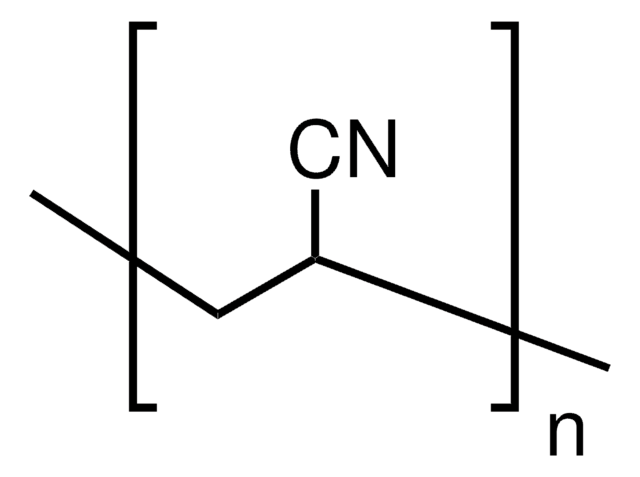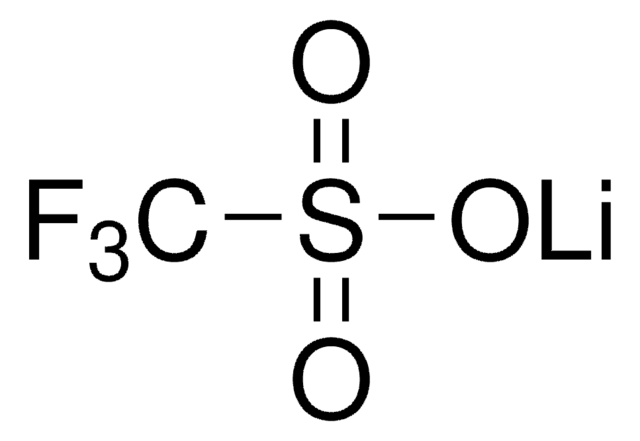182028
Poly(ethylene oxide)
average MV 600,000 (nominal), powder, hydroxyl, BHT as inhibitor
Synonym(s):
Polyethylene oxide, PEO
About This Item
Recommended Products
product name
Poly(ethylene oxide), average Mv 600,000 (nominal), powder
form
powder
Quality Level
mol wt
average Mv 600,000 (nominal)
contains
200-500 ppm BHT as inhibitor
viscosity
4,500-8,800 cP, 5 % in H2O(25 °C, Brookfield)(lit.)
transition temp
Tm 65 °C
Ω-end
hydroxyl
α-end
hydroxyl
application(s)
battery manufacturing
SMILES string
[H]OCCO
InChI
1S/C2H6O2/c3-1-2-4/h3-4H,1-2H2
InChI key
LYCAIKOWRPUZTN-UHFFFAOYSA-N
Looking for similar products? Visit Product Comparison Guide
General description
Application
- Bioabsorbable and injectable hydrogels for sustained drug release.
- PEO/graphene oxide composite electrolyte membrane for fuel cells.
- Poly(ethylene oxide)-b-poly(ε-caprolactone) (PEO-b-PCL) diblock copolymer. Losartan potassium encapsulated (PEO-b-PCL) copolymer can be used as a drug carrier.
Storage Class Code
11 - Combustible Solids
WGK
WGK 1
Flash Point(F)
Not applicable
Flash Point(C)
Not applicable
Personal Protective Equipment
Choose from one of the most recent versions:
Already Own This Product?
Find documentation for the products that you have recently purchased in the Document Library.
Customers Also Viewed
Articles
In this article, we discuss issues critical to successful application of the electrospinning technique, including control of individual nanofibers to form secondary structures and assembly of nanofibers into 3D architectures.
Progress in biotechnology fields such as tissue engineering and drug delivery is accompanied by an increasing demand for diverse functional biomaterials. One class of biomaterials that has been the subject of intense research interest is hydrogels, because they closely mimic the natural environment of cells, both chemically and physically and therefore can be used as support to grow cells. This article specifically discusses poly(ethylene glycol) (PEG) hydrogels, which are good for biological applications because they do not generally elicit an immune response. PEGs offer a readily available, easy to modify polymer for widespread use in hydrogel fabrication, including 2D and 3D scaffold for tissue culture. The degradable linkages also enable a variety of applications for release of therapeutic agents.
Devising biomaterial scaffolds that are capable of recapitulating critical aspects of the complex extracellular nature of living tissues in a threedimensional (3D) fashion is a challenging requirement in the field of tissue engineering and regenerative medicine.
Our team of scientists has experience in all areas of research including Life Science, Material Science, Chemical Synthesis, Chromatography, Analytical and many others.
Contact Technical Service








